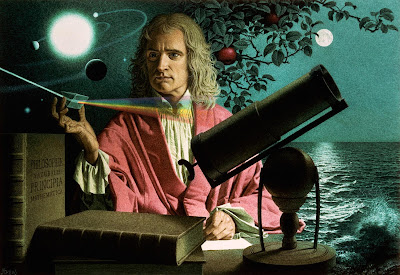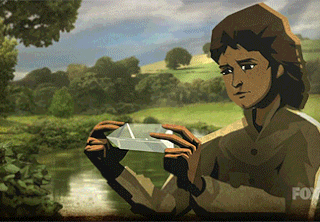Today (December 25, 1642) is the birthday of the philosopher Isaac Newton, who studied extensively in the fields of mathematics, mechanics, and gravity and was important in the scientific revolution.

Sir Isaac Newton was born on
Christmas Day, December 25, 1642, into an average farming family in Wollstorp,
near Golsterworth, Lincolnshire, England. Her father died three months before
she was born. Two years later Newton was left in the care of his grandmother
and his mother moved in with her new husband. Her childhood was unhappy and
restless. He joined the school at the age of 12. He was a very backward normal
student in school. Instead of studying at school, he was interested in drawing
and graduating. But at the age of making fun of himself, he began to read
better, gaining self-confidence after marrying a boy older than himself. Newton
was involved in science from an early age.

He also developed a clock that
works on the water at an early age. When he was fourteen, he had to drop out of
school due to family poverty. His uncle, aware of Newton's desire for
education, enrolled him in 1661 at the prestigious Cambridge University in
England. There he excelled in mathematics and physics and became an outstanding
student. While studying at university he discovered mathematical formulas and
binomial series theorems. He discovered the mathematical system of differential
arithmetic and summative arithmetic, which is powerful enough to know nature. This
discovery helped to apply the mathematical method in physics. The teaching of
the college at that time was the same as that of Aristotle. But he also wanted
to study the concepts of modern philosophers of the time, such as Newton,
Descartes, Galileo, Copernicus and Kepler.

He graduated in 1665 with a
bachelor's degree. After he graduated, the university was closed due to the
plague. As he stayed at home for the next two years, he explored calculus,
optics, and gravity. Within two years of his graduation, his scientific brain
began to function immensely. He discovered various elements of modern
mathematics. Divisions of modern mathematics such as the generalized binomial
theorem and the infinitesimal calculus are his discoveries. He devised methods
to find the area of curved objects and the capacity of solid objects. He
turned his research to astronomy in 1664. That is, he began to engage in
research on the planets in the sky. He began to think seriously about how the
thin strips around the moon formed. He experimented with the difference between
this beam of light and the beams of light in a rainbow. Many were amazed at his
findings. The officers who saw his research knowledge offered to pay him a
stipend. He put forward his ideas according to Kepler's arguments about the
planets and succeeded in doing so. But before Newton, many scientists published
the results of research on the position of the planets. Newton continued his
research behind their research.

Although many believe that Newton
was the first to discover the gravitational pull of the earth, even before
that, many discovered that objects fall down due to the pull of the earth.
However, Isaac Newton was the first to discover that this gravitational force
is responsible for the motion of the planets and that the velocities vary in
motion relative to how far away the planets are from the Sun. If his friend
Waldo had not written notes about Newton, we would not have known about
Newton's apple pie. One day Newton was sitting in his garden studying. Then an
apple fell from the apple tree there. Newton's thought when he saw it went to
the apple tree. Then what was the reason he fell from the apple tree and the
apple came straight to earth and fell? He wondered why the fruit did not go on
the tree. So he realized that the earth was taking over not only ordinary
objects but also the planets. The event that caused him to think that day was
due to the invention of motion and the canon of planetary rotation bound by the
law of gravity.


He concluded that the key to the
planet's orbit around the sun was causing the apple to fall from the tree. At
the age of 24, he became famous in 1666 for publishing the Law of Gravity. In
1667, at the age of 25, he was appointed professor of physics at Newton Trinity
College. He was given honorary responsibility at Trinity College. His friend
Dr Barrow resigned from his post. When a discussion of mathematics arose, Dr
Barrow was amazed to see the notes that Newton had already written. In it,
Galileo had clearly explained the great things that had been left halfway
through. Newton spent his days and nights researching the distances of the
planets, which vary many times over, and how that force pulls them together. He
was conducting this research in Lincolnshire. He was unable to continue the
research because the place was uncomfortable. Knowing the shape of the earth
and its circumference, he calculated the planets. He had not been engaged in
any other work for two years.


"Patience in thinking and
active effort are the main reasons for my success. I have no other thought than
this," he said. Newton's first law stated that an external force is
essential to move a stationary object, and that force is essential to change
the motion of an object. The second rule is that when an object changes its
position, the object changes speed and direction in the same direction
according to the magnitude of the force.

For each reaction, an equivalent reaction occurs from the opposite direction. The two forces, which appear to be working opposite each other, stand in equal measure and determine the course of the object. The third rule explains that since one force is not separate, it is always two-open. When we push an object by one type of force, another force is placed on it against that force and obstructs our force. In 1687 he published Philosophiae Naturalis Principia Mathematica, a treatise on gravity. Through his laws of motion, he introduced the field of classical mechanics. Not bright co-founded Wilhelm Leibniz with the development of the field of differential calculus. In Newton's Principia itself, the next three centuries saw the emergence of the laws of motion and general gravity, which dominated the scientist's view of the physical universe. It explained that the motions of objects on Earth and the motions of objects in outer space, such as planets, could be described based on the same principles.

He discovered the effects of
light falling on a triangle called a prism. He explained in the recipe that
when the sun's light passes through a prism, it splits into seven colours. He
also showed that when a multi-coloured Newton's disk rotates, it turns white. He
was the first to describe white light as a combination of multi-coloured light.
He closed one eye and stared at the sun with the other eye to research the
colours. Suddenly the colours began to change. As a result, Newton suffered damage
to that eye. I had to remove the floating spots in front of the eyes from the
darkroom for several days. The emission theory of light was laid down by
Newton. The theory is that light is visible only when particles emitted from a
distant glowing object journey at a speed of one hundred and ninety thousand
miles per second in space.

He is also notable for his claims
that light is made of cloth. Wave-fabric duality is defined as the force of
gravity between two particles is inversely proportional to their masses and
inversely proportional to the gap between them. He studied the nature of light
in-depth and focused on the development of telescopes. He also made telescopic
glasses that were six inches long and one inch in circumference. In one year he
also built a telescope. Thereby he was able to see the moons of Jupiter Cole.
Today's modern telescopes are based on Newton's first telescope. The spectacle he
invented is still in the Royal Society of London.

When he was working at Trinity
College, he was 51. He had it all on the table to publish all of his notes as a book. Newton's dog then fought the rat, seeing a mouse
bite and destroy the notes. Then the candle that was burning next to it fell on
the note and all burned to ashes. Without any anger at Newton's dog returning
to the temple, he asked, "Did you see what had happened?" Newton's
mind was greatly disturbed by the complete destruction of his lifelong
collections of notes, and his friend Hayley, realizing that Newton had a wealth
of knowledge, encouraged Newton to publish them all in a book, and in 1687
published the book "Mathematical Principles of Natural Philosophy".
The book is considered one of the greatest science fiction books ever
published.


At a special ceremony in
Cambridge in 1705, Queen Annie honoured Newton with the title of
"Sir." The vast ocean is invisible to my eyes. “Newton, who had gone
to London to preside over a meeting of the Royal Society, returned home unwell.
Isaac Newton, a philosopher who made important discoveries in the scientific
revolution, died in England on March 20, 1727, at the age of 85. He was buried
in the famous "Westminster Abbey" in London. He was engraved in the
tomb as The Best and Invaluable Gem of Mankind. Although many pay homage to
Newton, the tribute written by the Pope is profound. This saying is still
engraved in Newton's birthday room! "Nature and its laws were in darkness,
God ... Newton said let light be born".
Source By: Wikipedia
Information: Dr. P. Ramesh, Assistant
Professor of Physics, Nehru Memorial College, Puthanampatti, Trichy.
Get information like this
https://t.me/joinchat/jpqj3jQLN51kYTk9
Join Telegram Group.
https://chat.whatsapp.com/HHC5m0Jz3Ue1E8ilgta0YT
Join WhatsApp Group
Thanks.
Also, Read
🛑👍 CSIR-NET Physics Materials and Problems
🛑📕 21 GB and Hundreds of Physics E-Books Collection.
🛑🛥️ How does an Electric Motor work? (DC Motor).
🛑🤹♂️ Science Academies' Summer Research Fellowship Programme for Students and Teachers 2022.
🛑🔌 How does a Transformer work - Working Principle electrical engineering.
🛑🎙️ Transistors Explained - How transistors work.
🛑🔥⚡ How Thermocouples Work - basic working principle.
🛑🔌 Voltage Explained - What is Voltage? Basic electricity potential difference
🛑🔌 What is CURRENT– electric current explained, electricity basics.


.jpg)
No comments:
Post a Comment